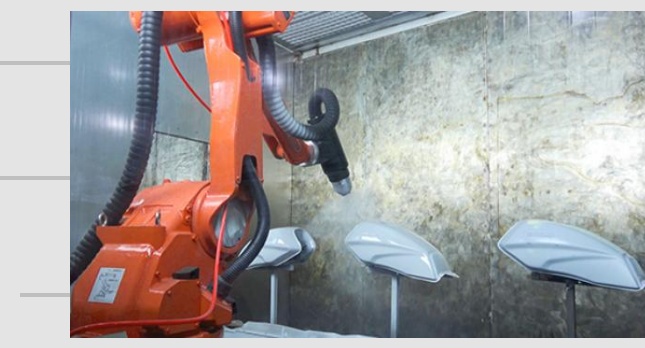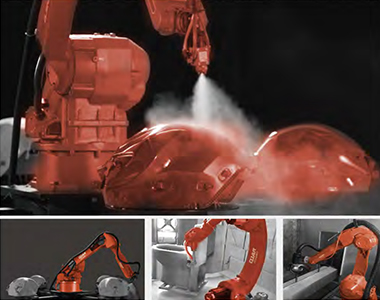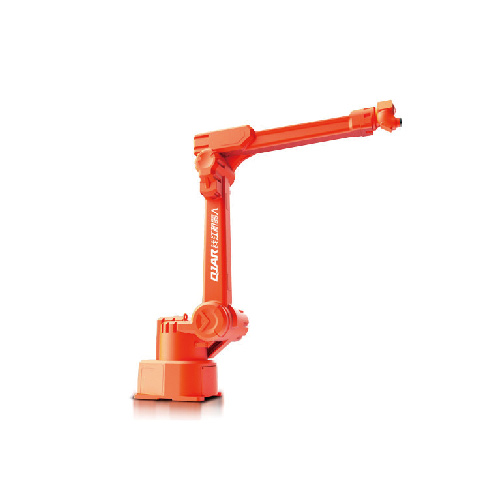Automatic spraying robots can revolutionize the way you paint. These machines combine precision with automation to reduce paint waste and increase efficiency. They use technologies such as electrostatic spraying, automated programming and other techniques to ensure that paint only adheres to the intended surfaces. This reduces overspray, and costs. After adopting robot spray painters, one leading automotive manufacturer reported a 30% reduction in waste paint and a 20% decrease in energy consumption. This innovation improves efficiency and supports environmentally-friendly practices by reducing emissions and waste.
Mechanisms of Automatic Paint Spraying Robots
Precision Spray Applications Precise spray patterns enable for targeted application.
Automated paint spraying robots excel in producing controlled spray patterns, ensuring paint only lands where intended. Their advanced programming creates precise trajectories to eliminate uneven application of color; by targeting specific areas you can achieve a flawless finish while decreasing unnecessary paint usage – making these robots the perfect choice for intricate designs or complex surfaces.
Real-time adjustments using sensors and AI are now possible.
Modern spray painting robots utilize sensors and AI technology to quickly adapt to changing conditions during operation.
AI and machine learning analyze previous jobs to optimize parameters such as speed, pressure and paint flow. Sensors measure environmental factors like temperature and humidity for dynamic adjustments from the robot.
Real-time adjustments ensure consistent performance, minimize waste, and optimize efficiency even in challenging environments.
Minimizing Overspray
Advanced nozzles for accurate paint delivery
The nozzles used in automated spray painting solutions are engineered for precision.
- Materials like PTFE and ceramic enhance durability and chemical resistance.
- Atomization technology ensures fine droplet formation for better coverage.
- Adjustable spray patterns allow you to modify the angle and width to suit specific applications.
These features work together to minimize overspray, ensuring paint is applied only where needed.
Reducing paint dispersion outside target areas
Automatic paint spraying robots employ innovative methods to limit paint dispersion.
| Method | Description |
|---|---|
| Electrostatic Spray | Maximizes paint transfer efficiency, reducing waste and enhancing finish quality. |
| Airless Spray | Uses high pressure to atomize paint, resulting in less overspray and higher efficiency. |
| HVLP (High Volume, Low Pressure) | Utilizes high air volume at low pressure for a smoother finish with less overspray. |
By using these techniques, you can achieve a cleaner application with minimal material loss.
Efficient Paint Usage
Automated calibration for optimal paint flow
Spray painting robots feature automated calibration systems that regulate paint flow. This ensures the right amount of paint is used for each application, preventing overuse. By optimizing paint flow, you can save resources and reduce operational costs without compromising quality.
Consistent thickness and coverage
Robotic automation ensures uniform paint application across all surfaces.
- Robots control spray angle, speed, and flow intensity with precision.
- Advanced technology guarantees even coverage, even on complex shapes.
- Optimized paint usage minimizes waste while maintaining superior adhesion.
This consistency in application reduces the need for rework, saving time and resources while delivering professional results.
Benefits of Spray Painting Robots

Cost Efficiency
Lower paint consumption and reduced waste
Spray painting robots help you achieve significant cost savings by reducing material waste. These robots optimize paint transfer efficiency, ensuring more paint adheres to the target surface and less is lost to overspray.
- They minimize the need for touch-ups, which further reduces material costs.
- Energy-efficient designs allow for economical paint usage while maintaining high-quality finishes.
- By controlling spray patterns and flow rates, these robots ensure precise application, cutting down on unnecessary expenses.
With these advantages, you can lower your overall paint consumption and reduce operational costs without compromising on quality.
Automation reducing labor costs
Automation in spray painting reduces your reliance on manual labor, leading to substantial savings.
- Robots can perform tasks equivalent to three employees, significantly lowering workforce requirements.
- Automated systems enhance production efficiency and minimize human error, ensuring consistent results.
- By reducing retraining needs and salaries, you can allocate resources to other critical areas of your operations.
This streamlined approach not only saves money but also boosts productivity across your production line.
Environmental Impact
Decreased emissions and compliance with regulations
Spray painting robots support your sustainability goals by reducing emissions and ensuring regulatory compliance.
- High-precision application minimizes overspray and waste, cutting disposal costs and environmental harm.
- Energy-efficient designs adjust consumption based on production needs, lowering your energy footprint.
- These robots can apply eco-friendly coatings, such as water-based or low-VOC paints, promoting healthier work environments and meeting environmental standards.
By adopting this technology, you can align your operations with green initiatives while maintaining efficiency.
Reduced environmental pollution from paint waste
Automatic paint spraying robots help you reduce pollution by optimizing paint usage. Their precision ensures minimal material waste, which decreases the amount of harmful chemicals released into the environment. Additionally, their ability to handle eco-friendly coatings further reduces the impact of industrial painting on ecosystems. This makes them an essential tool for companies prioritizing sustainability.
Enhanced Quality
Uniform and professional finishes
Spray painting robots deliver unmatched consistency in paint application. They eliminate variations in thickness, ensuring a smooth and uniform finish every time. By controlling flow rates and air pressure, these robots achieve professional-grade results that meet the highest standards. This level of precision enhances the overall quality of your products, making them more appealing to customers.
Fewer reworks and touch-ups
With spray painting robots, you can significantly reduce the need for reworks and touch-ups. Their ability to maintain consistent application minimizes errors, leading to fewer defects. This not only saves time and resources but also ensures your production process runs smoothly. By investing in this technology, you can focus on delivering high-quality products without the hassle of frequent corrections.
Industries Leveraging Automatic Paint Spraying Robots

Automotive Sector
Precision painting of car bodies and parts
You can achieve unmatched precision in painting car bodies and parts by using spray painting robots. These robots ensure every layer of paint is applied uniformly, eliminating inconsistencies. For example, BMW’s Regensburg assembly plant uses AI-controlled robots to inspect and process painted vehicle surfaces. These robots detect variations in paintwork and adjust accordingly, ensuring flawless finishes. This level of precision enhances the quality of automotive products, making them more appealing to customers.
High-volume production with minimal waste
Spray painting robots are optimized for high-volume production, making them ideal for automotive manufacturing. They automate repetitive tasks, reducing programming time and increasing efficiency.
| Benefit | Description |
|---|---|
| Consistent Paint Application | Robots provide uniform layers with minimal overspray, ensuring high-quality finishes. |
| Reduced Material Waste | By controlling flow rates, robots decrease paint usage, saving costs and reducing waste. |
| Increased Production Speed | Automation allows for rapid adjustments and minimizes setup time, enhancing overall efficiency. |
By integrating these robots into your high-volume painting operation, you can reduce waste, save costs, and boost productivity.
Manufacturing and Industrial Equipment within our service are coated consistently for top performance.
Spray painting robots improve the quality of coatings applied to industrial machinery and tools. Their precise application of multiple layers from various products produces durable and professional finishes, as well as decreased downtime associated with cleaning or refilling, thus increasing operational efficiency. Furthermore, multiple models can be painted simultaneously along one line, increasing productivity significantly – making spray painting robots an essential tool in modern industrial painting!
Protecting surfaces while using minimal material usage
Use spray painting robots to effectively protect surfaces while minimizing material usage by taking advantage of automated painting solutions. These machines provide precise controls that optimize paint application to only use what is necessary, while techniques like electrostatic atomization further ensure an even coat is applied, thus minimizing overspray. Automated solutions can cut paint usage up to 30% compared to manual approaches resulting in long-term cost savings and increased surface protection.
Furniture and Woodworking With Precision. Applying finishes to furniture requires precision.
Spray painting robots add precision to furniture finishing. Their even application of paint, without drips or imperfections, reduces wasteful floor space use in your factory and their slim designs allow them to operate in tight places – freeing up valuable floor space that could otherwise go to waste. Their slim designs also enable them to operate efficiently in tight places while their robotic arms can reach difficult areas efficiently without wasteful paint usage – for flawless finishes that enhance appeal of your furniture products.
Overspray on intricate designs should be kept to a minimum by carefully controlling overspray.
Spray painting robots excel at minimizing overspray when working with intricate furniture designs, using advanced technologies like computer vision and artificial intelligence to analyze surfaces and apply paint precisely, eliminating drips and imperfections while providing cleaner applications and reduced material waste on even the most intricate of designs. By adopting one, you can achieve cleaner applications while decreasing material waste even for complex projects.
How to Implement Spray Painting Robots in Your Operations

Assessing Operational Needs
Evaluating current paint usage and wastage
Before automating the spray painting process, you need to evaluate your current paint usage and wastage. This step helps identify inefficiencies and areas where spray painting robots can make the most impact. Consider the following factors:
| Factor | Description |
|---|---|
| Type of painting task | Assess the nature of your tasks to select robots that match your operational needs. |
| Features | Look for advanced programming capabilities and internal cable designs for smoother operation. |
| Payload and reach | Ensure the robot can handle the required weight and reach all target areas effectively. |
| Speed and efficiency | Balance speed with quality to enhance production without compromising the finish. |
| Ease of programming | Choose user-friendly robots for quick setup and adjustments. |
| Cost | Evaluate both initial investment and long-term costs, including maintenance and energy usage. |
By addressing these factors, you can reduce material waste, enhance production speed, and lower labor costs.
Identifying areas for improvement
Pinpointing areas for improvement ensures you maximize the benefits of automation. Spray painting robots excel in high-volume production, providing consistent results and reducing errors. They can save up to 30% in paint usage compared to manual methods. Key areas to focus on include:
- Labor cost reduction through workforce optimization.
- Decreased material waste by improving paint transfer efficiency.
- Enhanced production speed for faster project completion.
- Lower maintenance costs due to the reliability of modern robots.
Selecting the Right Robot
Choosing models like QJAR Robotics Painting Robot for specific needs
Selection of an ideal robot is key to meeting your goals, and models such as the QJAR Robotics Painting Robot are tailor-made to meet varying requirements. From intricate designs to mass applications, these versatile bots can handle them all smoothly thanks to advanced software which ensures smooth operation; their payload and reach capabilities make them suitable for different industries; for instance the QJR6-2700P model excels at precision tasks while QJR20-1600 has proven itself ideal in high volume production settings.
| Feature | Description |
|---|---|
| Type of painting task | Matches specific tasks, ensuring smooth and precise application. |
| Features | Includes internal cables and advanced programming for complex operations. |
| Payload and reach | Covers large or intricate surfaces with ease. |
| Speed and efficiency | Balances fast operation with high-quality finishes. |
| Ease of programming | Simplifies setup and adjustments for efficient production. |
| Cost | Offers long-term savings through reduced material and maintenance costs. |
Considering budget, ROI, and industry requirements
When selecting a robot, consider your budget and expected return on investment (ROI). While the initial cost may seem high, the long-term savings often outweigh it. Benefits include reduced labor costs, decreased material waste, and enhanced production speed. Additionally, advanced technology improves quality and efficiency, making your business more competitive in the market.
Training and Maintenance
Training staff to operate and program the robots
Proper training ensures your team can operate and maintain the robots effectively. Comprehensive programs cover safety procedures, robot operation, and programming. Key training areas include:
- Robot Operation: Loading/unloading parts, starting/stopping the robot, and monitoring the painting process.
- Programming: Using teach pendants and software to create and modify painting paths.
- Maintenance: Routine maintenance, troubleshooting, and problem-solving skills.
Periodic refresher courses and training for new models or software upgrades keep your team up-to-date.
Regular maintenance for optimal performance
Maintaining your robots ensures consistent performance and longevity. Best practices include:
- Cleaning the spray gun and reservoir after each use to prevent paint buildup.
- Inspecting hoses, fittings, and filters for wear or damage.
- Lubricating moving parts to reduce friction and wear.
- Monitoring paint quality and viscosity for proper application.
Regular inspections and proper cleaning procedures prevent costly repairs and downtime, ensuring your automated painting solution operates at peak efficiency.
Automated paint spraying robots have revolutionized painting processes. Not only do they reduce waste and improve efficiency, but their precision also guarantees targeted application while advanced technologies reduce overspray. Automotive and furniture industries alike have seen remarkable results; one manufacturer achieved 30 percent less paint waste and 20 percent fewer energy usage through using automated robots to spray. Furthermore, these eco-friendly bots allow manufacturers to use eco-friendly coatings while decreasing emissions from emissions reduction measures – providing a great opportunity to improve quality while decreasing costs while aligning operations with sustainable practices!
Benefits of this technology far outweigh its initial costs and challenges.
